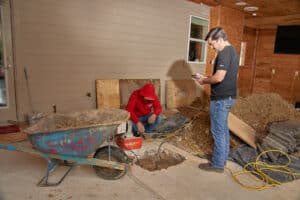
Frequently Asked Questions About Foundation Repair
If your home is less than ten (10) years old, the foundation should still be covered by the builder’s warranty. Your first call should be to your builder to evaluate the foundation.
You should contact the foundation repair company that did the work to determine the following:
1. Are they still in business?
2. Does the work completed still have a warranty?
3. Are they willing to come look at it?
If the answer is no to any or all of these questions then you should consult with another foundation repair company about your concerns. But be prepared. We will have to evaluate it as if it had never been repaired before because we don’t know the piering type, where piers are installed or if they leveled it or not. It’s a clean slate when we look at it.
No. These are cosmetic and not structural. The official term is spalding. Sometimes at the corners a portion of the concrete may fall off. Often, cracks occur in the concrete lathe or finishing coat around the perimeter of the home. These are surface cracks. Best to call someone that does concrete flatwork or finish out to address these concerns.
It’s merely cosmetic and most of the time it is just an area surrounding the end of a post-tension cable that runs thru the slab. It will look rusted sometimes as well. It really doesn’t require repair, but if it’s visually concerning, best to call someone that does concrete flatwork or finish out to address this concern.
No. Our piering method requires significant weight from a structure atop of concrete to install them. Flatwork such as patio slabs or driveways are too light for pier installation to correct. You have one of two options. Breakout and repour them. Typically the least expensive option. There are also several concrete raising companies that can inject a mixture to level-out sidewalks and or driveways if there is deflection between the sections.
First, call a plumbing company and have them perform a test on the incoming water lines from the city and a drain line test. This test is merely a pass or fail outcome. Cost for this varies from company to company but is usually around $400-$700. If a leak is found, additional tests at additional cost are required to locate the leak(s). If no leaks are found you may want to monitor it to see if it occurs during or after heavy rainfall. If it does, the drainage around your home may need to be corrected by a landscaping company.
No.
No. Best to find someone who specializes in “stucco underpinning”. A simple Google search and a couple phone calls and you should be able to find someone to help you with this.
No. It would be a conflict of interest to do so. Third party engineers have to evaluate our work for our permits.
Yes. We will need to look at inside cosmetic damage resulting from foundation movement and to take floor elevation readings to determine the level or out-of-level condition of the foundation.
Typically not. A handful of floor elevation readings will need to be taken inside the home. It’s important that we have access to exterior walls of the home as well some interior locations. Typical furniture arrangements and a bit of clutter does not hinder our ability to get what we need.
Yes.
No. We don’t write or issue formal reports. Our inspections are free. If you want a report to represent your homes’ condition it’s best to hire a Structural Engineer to evaluate the foundation and formally report their findings.
Foundation repairs are some of the costliest issues a homeowner will ever experience. Pier and beam foundation repairs range from $4,000 to more than $10,000. There are many factors in the cost of a pier and beam foundation repair. Awareness of these factors can help you decide how to proceed with the project and which contractor to use for the job.